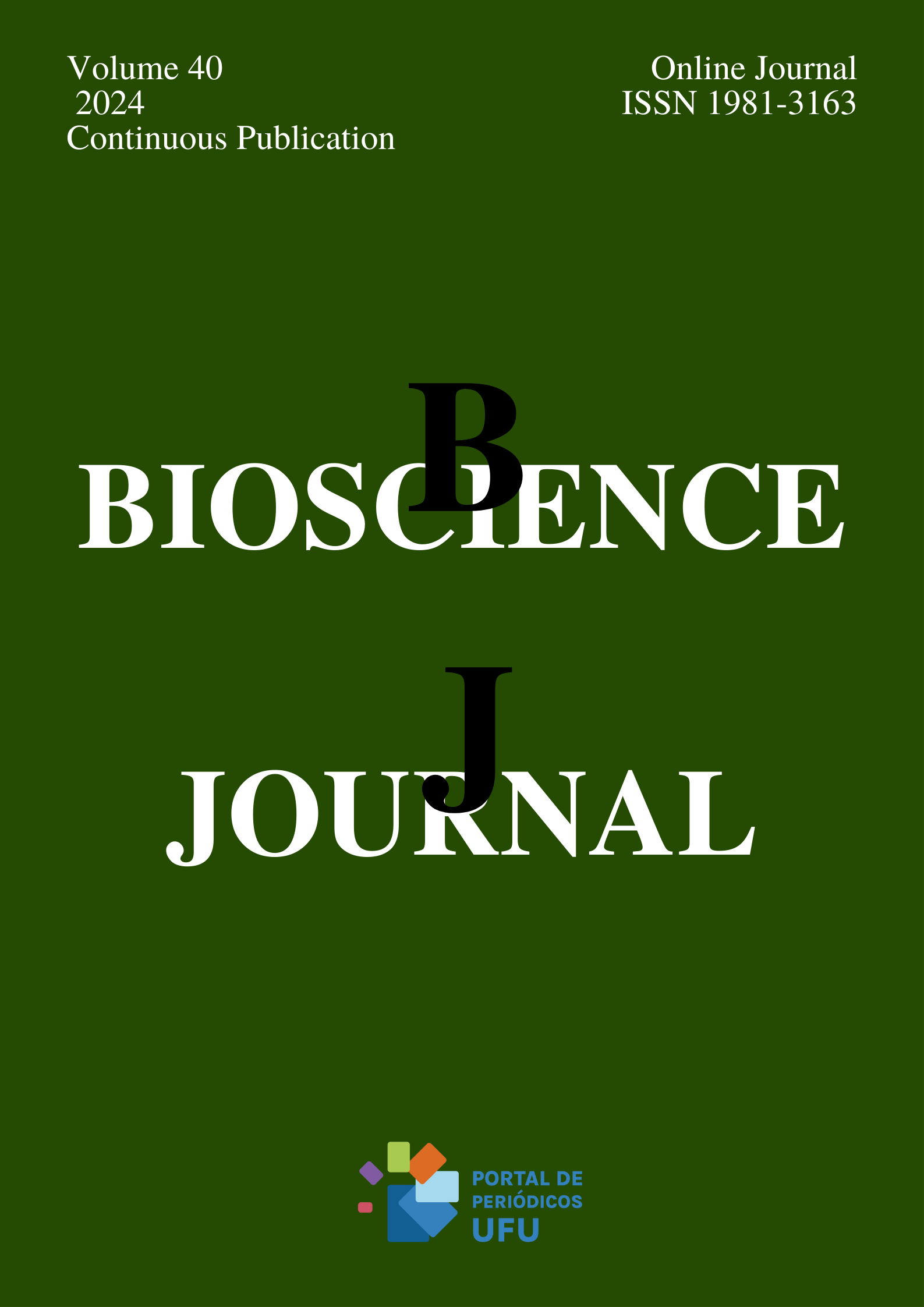Monocyte-lymphocyte, neutrophil-lymphocyte, and platelet-lymphocyte ratios as inflammatory biomarkers of clinical dengue severity
DOI:
https://doi.org/10.14393/BJ-v40n0a2024-67413Keywords:
Blood cell count, Dengue hemorrhagic fever, Dengue virus, Leukocyte count, Prognostic.Abstract
The literature describes monocyte-lymphocyte (MLR), neutrophil-lymphocyte (NLR), and platelet-lymphocyte (PLR) ratios as prognostic biomarkers. However, in the case of dengue infection, patient clinical management and nonspecific laboratory tests determine the prognosis. Therefore, this study analyzed MLR, NLR, and PLR as prognostic biomarkers of dengue infection. Our study was based on a clinical cohort of dengue patients in Brazil between 2012 and 2013. From 193 patients, 164 (85.0%) were classified as dengue fever (DF), 19 (9.8%) as dengue hemorrhagic fever (DHF), and 10 (5.2%) as intermediate DF/DHF. DHF cases were significantly associated with MLR > 0.13 (OR: 5.72, 95% CI: 1.28-25.60, p < 0.05) and PLR ≤ 80.68 (OR: 4.26; 95% CI 1.60-11.33; p < 0.05). Our results suggest that MLR increase, and PLR decrease indicate a higher likelihood of worsening the clinical status.
References
ARGOLO, A.F.L.T., et al. High frequency of pre-existing neutralizing antibody responses in patients with dengue during an outbreak in Central Brazil. BMC Infectious Diseases. 2016, 3(546), 1-8. https://doi.org/10.1186/s12879-016-1867-6
BARNIOL, J., et al. Usefulness and applicability of the revised dengue case classification by disease: Multi-centre study in 18 countries. BMC Infectious Diseases. 2011, 11, 1-12. https://doi.org/10.1186/1471-2334-11-106
BASU, A., et al. Dengue 2 virus inhibits in vitro megakaryocytic colony formation and induces apoptosis in thrombopoietin-inducible megakaryocytic differentiation from cord blood CD34+ cells. FEMS Immunology and Medical Microbiology. 2008, 53(1), 46-51. https://doi.org/10.1111/j.1574695X.2008.00399.x
BRAZIL. MINISTÉRIO DA SAÚDE. 2005. Dengue com complicações. Espectro clínico. In: Secretaria de Vigilância em Saúde. eds. Dengue: Diagnóstico e Manejo Clínico. Brasília: Diretoria Técnica de Gestão. 2 ed., pp. 26.
BRAZIL. MINISTÉRIO DA SAÚDE. Boletim Epidemiológico. Brasília-DF: Secretaria de Vigilância em Saúde, 2014.
BRAZIL. MINISTÉRIO DA SAÚDE. DENGUE. Diagnóstico e Manejo Clínico. Adulto e Criança. 5 ed. Brasília-DF: Ministério da Saúde, 2016.
CASTILLO, J.A., et al. Role of Monocytes in the Pathogenesis of Dengue. Archivum Immunologiae et Therapiae Experimentalis. 2019, 67(1), 27-40. http://dx.doi.org/Doi:10.1007/s00005-018-0525-7
CATTARINO, L., et al. Mapping global variation in dengue transmission intensity. Science Translational Medicine. 2020, 12(528), 1-11. http://dx.doi.org/Doi:10.1126/scitranslmed.aax4144
CHALOEMWONG, J., et al. Useful clinical features and hematological parameters for the diagnosis of dengue infection in patients with acute febrile illness: A retrospective study. BMC Hematology. 2018, 18(1), 1-10. http://dx.doi.org/Doi:10.1186/s12878-018-0116-1
CONG, R., et al. Combination of preoperative neutrophil-lymphocyte ratio, platelet-lymphocyte ratio and monocyte-lymphocyte ratio: A superior prognostic factor of endometrial cancer. BMC Cancer. 2020, 20(1), 1-11. http://dx.doi.org/Doi:10.1186/s12885-020-06953-8
COSTA, V.V., et al. Inflammatory and Innate Immune Responses in Dengue Infection. The American Journal of Pathology. 2013, 182(6), 1950-1961. http://dx.doi.org/Doi:10.1016/j.ajpath.2013.02.027
DEMIRDAL, T. and SEN, P. The significance of neutrophil-lymphocyte ratio, platelet-lymphocyte ratio and lymphocyte-monocyte ratio in predicting peripheral arterial disease, peripheral neuropathy, osteomyelitis and amputation in diabetic foot infection. Diabetes Research and Clinical Practice. 2018, 144, 118-125. http://dx.doi.org/Doi:10.1016/j.diabres.2018.08.009
GAO, K., et al. The predictive role of monocyte-to-lymphocyte ratio in osteoporosis patient. Medicine. 2019, 98(34), 1-5. http://dx.doi.org/doi:10.1097/MD.0000000000016793
HALSTEAD, S.B. Pathogenesis of Dengue: Challenges to Molecular Biology. Science. 1988, 239(4839), 476-481. http://dx.doi.org/Doi:10.1126/science.3277268
HOTTZ, E.D., et al. Dengue Induces Platelet Activation, Mitochondrial Dysfunction and Cell Death through Mechanisms that Involve DC-SIGN and Caspases. Journal of Thrombosis and Haemostasis. 2014, 11(5), 951-962. http://dx.doi.org/Doi:10.1111/jth.12178
KHAN, E., et al. Demographic and Clinical Features of Dengue Fever in Pakistan from 2003 – 2007: A Retrospective Cross-Sectional Study. PLoS One. 2010, 5(9), 1-7. http://dx.doi.org/Doi:10.1371/journal.pone.0012505
KOTEPUI, M., PHUNPHUECH, B. and PHIWKLAM, N. Differentiating between dengue fever and malaria using hematological parameters in endemic areas of Thailand. Infectious Diseases of Poverty. 2017, 1-9. http://dx.doi.org/Doi:10.1186/s40249-017-0238-x
LEO, Y.S., et al. Utility of warning signs in guiding admission and predicting severe disease in adult dengue. BMC Infectious Disease. 2013, 13(1), 498. http://dx.doi.org/10.1186/1471-2334-13-498
LIN, C.F., et al. Generation of IgM anti-platelet autoantibody in dengue patients. Journal of Medical Virology. 2001, 63(2001), 143-149. https://doi.org/10.1002/1096-9071(20000201)63:2<143::AID-JMV1009>3.0.CO;2-L
MANDALIYA, H., et al. Prognostic biomarkers in stage IV non-small cell lung cancer (NSCLC): Neutrophil to lymphocyte ratio (NLR), lymphocyte to monocyte ratio (LMR), platelet to lymphocyte ratio (PLR) and advanced lung cancer inflammation index (ALI). Translational Lung Cancer Research. 2019, 8(6), 886-894. http://dx.doi.org/Doi:10.21037/tlcr.2019.11.16
MENG, X., et al. The platelet-to-lymphocyte ratio, superior to the neutrophil-to-lymphocyte ratio, correlates with hepatitis C virus infection. International Journal of Infectious Diseases. 2016, 45, 72-77. http://dx.doi.org/doi:10.1016/j.ijid.2016.02.025
PANG, J., et al. Discovery and Validation of Prognostic Biomarker Models to Guide Triage among Adult Dengue Patients at Early Infection. PLoS One. 2016, 11(6), 1-19. http://dx.doi.org/Doi:10.1371/journal.pone.0155993
PUJANI, M., et al. Association of Hematologic biomarkers and their combinations with disease severity and mortality in COVID-19- an Indian perspective. American Journal of Blood Research. 2021, 11(2), 180-190.
ROCHA, B.A.M., et al. Dengue-specific serotype related to clinical severity during the 2012 / 2013 epidemic in centre of Brazil. Infectious Diseases of Poverty. 2017, 6(116), 1-11. http://dx.doi.org/doi:10.1186/s40249-017-0328-9
RODRIGUES, N., et al. Analysis of Clinical and Laboratory Alterations Related to Dengue Case Severity : Comparison between Serotypes 2 and 4 in Brazil. American Journal of Tropical Medicine and Hygiene. 2017, 97(137), 137-145. http://dx.doi.org/doi:10.4269/ajtmh.16-0227
SAMANTA, J. and SHARMA, V. Dengue and its effects on liver. World Journal of Clinical Cases. 2015, 3(2), 125-132. http://dx.doi.org/doi:10.12998/wjcc.v3.i2.125
TAN, D., et al. Prognostic significance of lymphocyte to monocyte ratio in colorectal cancer: A meta-analysis. International Journal of Surgery. 2018, 55, 128-138. http://dx.doi.org/Doi:10.1016/j.ijsu.2018.05.030
VASEY, B., et al. Multivariate time-series analysis of biomarkers from a dengue cohort offers new approaches for diagnosis and prognosis. PLOS Neglected Tropical Diseases. 2020, 14(6), 1-19. http://dx.doi.org/Doi:10.1371/journal.pntd.0008199
XIANG, F., et al. Monocyte/lymphocyte ratio as a better predictor of cardiovascular and all-cause mortality in hemodialysis patients: A prospective cohort study. Hemodialysis International. 2018, 22(1), 82-92. http://dx.doi.org/Doi:10.1111/hdi.12549
WHO. WORLD HEALTH ORGANIZATION. Dengue haemorrhagic fever: diagnosis, treatment, prevention and control. 2nd ed. World Health Organization, 1997.
WHO. WORLD HEALTH ORGANIZATION. Dengue: Guidelines for Diagnosis, Treatment, Prevention, and Control. Geneva: World Health Organization, 2009.
Downloads
Published
Issue
Section
License
Copyright (c) 2024 Luiza Monteiro Böer, Isabela Cinquini Junqueira, Thais Cardoso do Nascimento, Adriana Oliveira Guilarde, Valéria Christina de Rezende Féres, Keila Correia de Alcântara

This work is licensed under a Creative Commons Attribution 4.0 International License.





